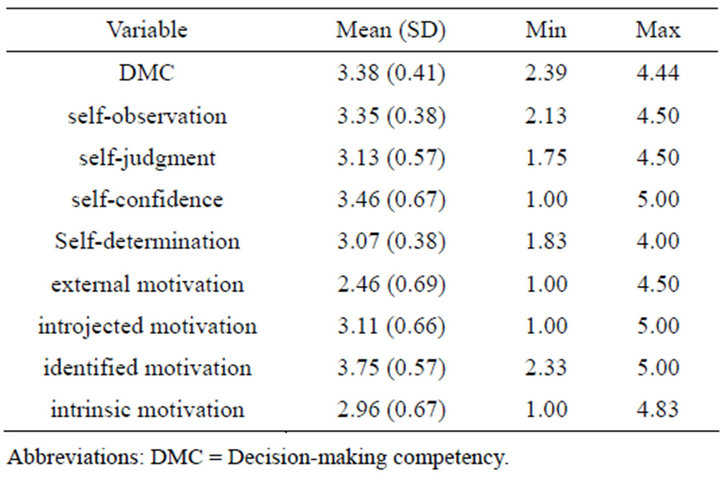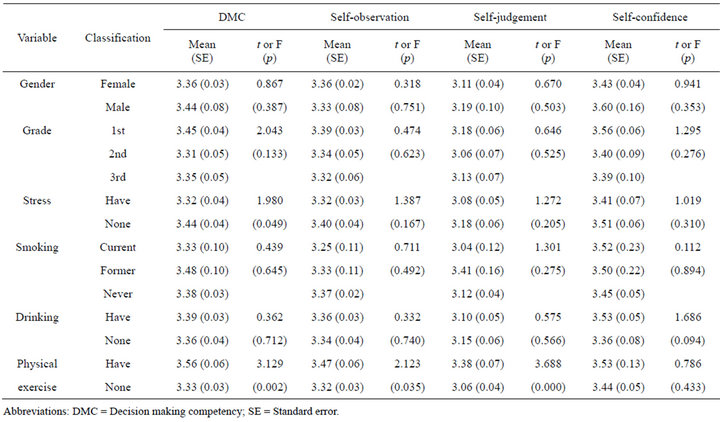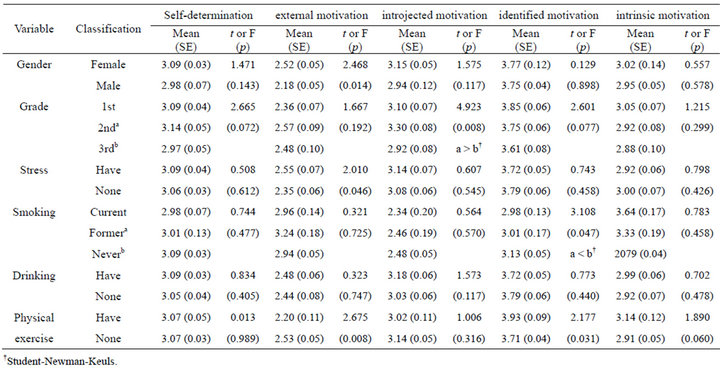Open Journal of Nursing
Vol.3 No.2(2013), Article ID:32474,6 pages DOI:10.4236/ojn.2013.32030
Decision-making competency, self-determination, and health lifestyle in nursing students
![]()
Department of Nursing, Hallym Polytechnic University, Chuncheon, Republic of Korea
Email: *jskim@hsc.ac.kr
Copyright © 2013 BongSuk Lee, Ji-Su Kim. This is an open access article distributed under the Creative Commons Attribution License, which permits unrestricted use, distribution, and reproduction in any medium, provided the original work is properly cited.
Received 17 March 2013; revised 17 April 2013; accepted 10 May 2013
Keywords: Undergraduate Nursing Students; Decision Making; Self-Determination; Lifestyle
ABSTRACT
Introduction: This study identifies and analyzes the levels of relations between decision-making competency, self-determination, and health lifestyle in nursing students. Methods: This study was designed as a descriptive research to identify the relations of nursing students’ decision-making competency, self-determination, and health lifestyle. The subjects were 187 nursing students. Data were collected using a structured questionnaire and were analyzed by the IBM SPSS Statistics 19 program. Results: Decision-making competency of nursing students was 3.38 ± 0.41 points, and self-determination was 3.07 ± 0.38 points. Stress and physical exercise were the general and healthrelated lifestyle factors that contributed to the differences in decision-making competency. There were no differences in self-determination according to these factors. Conclusion: The results of the study showed that the levels of decision-making competency and self-determination in nursing students were moderate. Further studies are recommended for the development of these core abilities in nursing students.
1. INTRODUCTION
Young adult years are a transitional period that starts during college life, wherein one goes through identity conflict, wandering, and confusion in an attempt to prepare oneself for the adult life; typically, this period is associated with high levels of stress among individuals [1]. In order to have a successful college life, it is important to expand one’s capability by properly adapting to changes and challenges encountered in the new college environment and to deal with stress by appropriate decision making and self-determination [2].
Decision making is a process by which one chooses the best from numerous alternatives through a comparative evaluation in order to solve a matter in hand [3,4]. Particularly for nursing students, the aim is to improve decision-making competency by involving them in clinical reasoning process [5], which requires them to organize and prioritize given information. Since the clinical decision making in nurses integrates the entire nursing practice and affects patient outcomes, it is a requisite for these future nurses to develop such important ability [6].
Along with decision-making competency, various competencies are coming up to the surface that nursing students must acquire, and one aspect that functions as energizer and regulator is motivation [7]. In self-determination theory (SDT), intrinsic motivation and extrinsic motivation are not simply opposite, nor is there a clear boundary between them. They are rather in continuance according to autonomy or self-determination that even with an interruption by an extrinsic motivation, intrinsic motivation can preserve self-determination [8].
In fact, in practicing health improvement, factors, such as personal lifestyle and changes in one’s environment, bring different outcomes but from the point of SDT. It is being reported that self-determination is something that can predict and determine whether one can start and maintain his or her chosen health behaviors [9,10].
Furthermore, since nursing students pursue a healthrelated field and are in charge of educating health issues to improve patients’ health, it is important to identify their health lifestyle [11]. It is therefore necessary to ascertain the relations of their decision making, self-determination, and health behaviors.
Most of the previous studies done on college students’ decision making or self-determination explored the young adults’ difficulties in deciding their career path [2,12,13] and thus ignored the importance of rational decision making and self-determination [14]. In addition, it is impossible to find such research conducted with nursing students. Therefore, a study comparing the degree of nursing students’ decision-making competency and selfdetermination with their health lifestyle is necessary.
2. METHODS
2.1. Study Design
This study was designed as a descriptive research to identify the relations of nursing students’ decision-making competency, self-determination, and health lifestyle.
2.2. Study Subjects and Data Collection Procedure
The subjects of this study were nursing students of a nursing junior college located in Gangwon-do, and the purpose of the study, willingness to participate, and confidentiality of shared information were discussed, agreed, and signed before they participated in the survey. Using G*Power 3.1 and assuming a significance level of 0.05, power of test of 0.95, and effect size of 0.05 (medium), 176 participants were necessary. Structured questionnaires were used, and 192 out of 200 questionnaires were collected between 03/18/2013 and 03/25/2013; out of 192, 187 questionnaires, excluding 5 no-response ones, were included in the data analysis.
2.3. Study Tool
Decision-making competency is a process of choosing a certain action from numerous alternatives in order to achieve one’s goal [3] and in this study, Decision-Making-Competency Inventory (DMCI), a tool that Miller & Byrnes (2001) [15] first developed and Park, Oh, Ham, Lim, & Lim (2012) [16] later revised, was used. DMCI consists of 18 questions: 8 self-observation questions, 2 self-confidence questions. It uses the rating standard 5- point Likert scale that measures from “strongly disagree” (1 point) to “strongly agree” (5 points); higher points indicate higher decision-making competency. Reliability (Cronbach’s α) of the study done by Park, Oh, Ham, Lim, & Lim (2012) [16] was 0.76, and in this study it was 0.783.
Self-determination shows the degree of self will and attributes involved in making decisions [17]. The tool used in this study to measure self-determination was what Hayamizu (1997) [18] first developed and Lee (2007) [17] revised. Self-determination tool consists of 24 questions and is divided into 4 categories: external motivation, introjected motivation, identified motivation, and intrinsic motivation, each consisting of 6 questions. It uses the rating standard 5-point Likert scale that measures from “strongly disagree” (1 point) to “strongly agree” (5 points); higher points indicate higher level of selfdetermination. Reliability of this study was Cronbach’s α 0.745.
Lastly, for health lifestyle, recognition of stress, smoking status, drinking status, and exercising status were surveyed.
2.4. Data Analysis
Collected data were analyzed using the IBM SPSS Statistics 19 program. Subjects’ health behaviors were analyzed by frequency and percentage, decision-making competency and self-determination were averaged, and set standard deviation was calculated. The difference between decision-making competency and self-determination according to health lifestyle was analyzed using t-test and F-test, and Student-Newman-Keuls’ method was used in the post-hoc test.
3. RESULTS
3.1. Subjects’ General Health Lifestyle, Decision-Making Competency, and Level of Self-Determination
Approximately 84.0% of the student subjects were female and 16.0% were male; 39.0% were freshmen, 32.6% were sophomores, and 28.3% were juniors. For health lifestyle, 54.5% recognized their stress, and 45.5% did not. Smoking status was estimated as 9.6% current smokers, 4.8% former smokers, and 85.6% never smokers. Drinkers were 56.1% and non-drinkers were 43.9%. About 20.3% said that they exercised regularly and 79.9% said that they did not.
The subjects’ decision-making competency and level of self-determination are shown in Table 1. Decisionmaking competency ranged from 2.39 points to 4.44 points, averaging 3.38 points. Average by subcategory showed that the subjects scored the highest on self-confidence with 3.46 points, followed by self-observation

Table 1. Decision-making competency and level of self-determination (n = 187).
with 3.35 points, and self-judgment with 3.1335 points. Level of self-determination ranged between 1.83 points and 4.00 points, averaging 3.07 points. By subcategory, identified motivation ranked the highest (3.75 points), followed by introjected motivation (3.11 points), intrinsic motivation (2.98 points), and external motivation (2.46 points).
3.2. Difference in Decision-Making Competency According to Health Lifestyle
The difference in decision-making competency according to health lifestyle is shown in Table 2. Decisionmaking competency was higher in male students than in female students, and by college level, it was highest among freshmen, followed by juniors, then sophomores, but there was no significant statistical difference found. Under the stress category, the ones that recognized stress had lower level of decision-making competency, which showed significant statistical difference (t = 1.980, p = 0.049). By smoking status, former smokers had the highest level of decision-making competency, followed by never smokers, then current smokers. Drinkers showed higher level of competency but did not show statistically significant difference. Under the exercise category, decision-making competency was higher in the ones who exercised regularly and this showed significant statistical difference (t = 3.129, p = 0.000). In those who exercised regularly, levels of self-observation (t = 2.123, p = 0.035) and self-judgment (t = 3.688, p = 0.000) were high and showed significant statistical differences.
3.3. Difference in Self-Determination According to Health Lifestyle
Difference in self-determination according to health lifestyle is shown in Table 3. Self-determination tended to be lower in male students and by college level, it was ranked from highest to lowest as sophomores, juniors, and freshmen; however, no significant statistical difference was present. According to stress recognition, those that recognized stress showed higher self-determination, and according to smoking status, self-determination was highest in never smokers, followed by former smokers, then current smokers. In addition, drinkers tended to show higher points, but exercise did not make significant difference. In aggregate, all of these showed no significant statistical differences. By subcategory, there were significant statistical differences in external motivation of females (t = 2.468, p = 0.014), those who recognized stress (t = 2.010, p = 0.046), and those who did not exercise (t = 2.675, p = 0.008). In case of introjected motivetion, sophomores showed higher points than juniors (F = 4.923, p = 0.008). In case of identified motivation, the former and never smokers had higher points (F = 3.108, p = 0.047), as well as those who exercised regularly (t = 2.177, p = 0.031), all of which showed significant statistical difference.

Table 2. Difference in decision-making competency according to health lifestyle (n = 187).

Table 3. Difference in self-determination according to health lifestyle (n = 187).
4. DISCUSSION
Decision-making competency and self-determination are two very important factors in clinical situation for nursing students as future nurses. According to the results of this study, the level of decision-making competency of nursing students was intermediate, and by subcategory, self-judgment was the lowest. Comparing the results with a previous study [2], the decision-making competency of college students, regardless of their academic major, tended to be in the intermediate level, and by subcategory, it showed lowest in self-judgment, which was similar to the present study. The subcategory self-judgment is related to recognition and judgment of one’s own action, which also means comparing and judging between one’s present performance and standard [16]. Therefore, college students who are in their early adult years are in a transitional period wherein their beliefs and standards are not yet established, and this result probably means that they are still lacking ability to make the best rational decision. Moreover, the level of self-determination of nursing students in this study was in the intermediate level and by subcategory, identified motivation ranked the highest and external motivation ranked the lowest, which was exactly the same with the results of previous studies [17,19]. By contrast to external motivation, identified motivation refers to making decisions according to his or her own will as he or she believes that a certain action is worthy in achieving a given goal or is of personal importance. In case of external motivation, it is a status that has the lowest autonomy among all other extrinsic motivations, which implies lacking self-will because it acts upon external limitations, and thus, selfdetermination is the lowest in this status [7,19]. In case of nursing students, they tend to act according to what they perceive as worthy, rather than the fact that they must obey rules or avoid penalties. However, they did not show satisfying results in terms of intrinsic motivation, which signifies the highest level of self-determination and making choices according to one’s inner pleasure or interest. In order for nursing students to acquire core competencies, they must increase their intrinsic motivation for studying, and nursing educators must also take interest in intrinsic motivation in the education field and make use of it.
The result of this study also showed that there was a difference in decision-making competency depending on nursing students’ general characteristics or health lifestyle, including whether one recognizes stress and exercises regularly. In case of those who did not feel stressed and had regular exercise, the level of decision-making competency was high. In this regard, it is not possible to check causality between variables but an explanation may be derived that by planning, evaluating, and judging one’s actions and making the best decisions accordingly, nursing students may feel less stress and can maintain long-term health lifestyle by engaging in regular physical activities. In external motivation, a subcategory of selfdetermination, the nursing students had differences depending on sex, stress recognition, and regular physical activities. Moreover, females who did not recognize stress and did not exercise regularly had higher external motivation levels than males. Such result was different from a previous study [7], which reported that sex did not make any difference in one’s external motivation. However, the reality that the nursing students who have limited freedom and must follow rules of authorities feel more stress and lack regular exercise seems to be related to their decision-making competency. In case of introjected motivation, sophomore students showed higher levels than did the junior students, which was different from a previous study that reported higher level of introjected motivation in high school students than in middle school students [19]. Introjected motivation signifies actions taken to be recognized by others rather than to avoid punishments, and it is considered that the time of data collection for this study must have affected the results. Data for this study were collected around end of March, which was the month after the sophomore students started with their clinical training. For this reason, it seems that the motivation of sophomores to be recognized by others and to avoid criticism in a new environment played an important role compared with other college levels but more accurate analysis through repetitive research is necessary. In case of identified motivation, the never smokers showed higher levels than the former smokers, especially those with regular exercise. By this, we can assume that the more nursing students act according to what they think is worthy, the less they tend to smoke and the more they have regular physical activities. Therefore, mediation modalities that can increase a subject’s intrinsic motivation level must be arranged and integrated into nursing education to maintain a healthy lifestyle.
5. CONCLUSION
As future nurses, nursing students should acquire core abilities necessary in clinical settings, including decision making and self-determination; thus, this study, which analyzed the relations of the variables and health lifestyle in nursing students pursuing a health-related field, is considered significant. Based on the results of this study, it is necessary to devise a program that will multidimensionally identify and develop the factors that affect decision-making competency and self-determination in nursing students.
REFERENCES
- Kown, D.B., Oh, Y.J., Park, H.M., Son, J.J., and Song, S.H. (2002) An exploring study on determining factors for college student’s degree of educational satisfaction. Journal of Educational Research, 40, 181-202.
- Park, M.J., Ham, Y.L. and Oh, D.N. (2012) Level and their correlations of decision-making-competency, adjustment to college life, satisfaction to college lie in freshman. The Journal of the Korea Contents Association, 12, 327-337. doi:10.5392/JKCA.2012.12.04.327
- Byrnes, J.P. (1998) The nature and development of decision-making: A self-regulation model. Erlbaum, Hillsdale.
- Kuhl, J. (2000) The volitional basis of personality systems interaction theory: Application in learning and treatment contexts. International Journal of Educational Research, 33, 665-703. doi:10.1016/S0883-0355(00)00045-8
- Ironside, P.M. and McNelis, A.M. (2011) Transforming clinical education. Journal of Nursing Education, 50, 123- 124. doi:10.3928/01484834-20110216-01
- Higgs, J., Jones, M.A., Loftus, S. and Christensen, N. (2007) Clinical reasoning in nursing in the health professions. Elsevier, Boston.
- Kim, A.Y. (2003) Motivation in the class. The Korean Journal of Educational Psychology, 17, 5-36.
- Ryan, R.M. and Connell, J.P. (1989) Perceived locus of causality and internalization: examining reasons for acting in two domains. Journal of Personality and Social Psychology, 57, 749-761. doi:10.1037/0022-3514.57.5.749
- Williams, D.M. (1989) Political theory and individualistic health promotion. Advanced Nursing Science, 12, 14-25.
- Sheldon, K.M., Williams, G.C. and Joiner, T. (2003) Self determination theory in the clinic: motivating physical and mental health. Yale University Press, New Haven.
- Sung, M.H. (2001) Determinants of health promoting life style of nursing students. The Journal of Korean Women’s Health Nursing Academic Society, 7, 317-330.
- So, Y.H. (2011) Analysis of the structural relations among self-determination need, career attitude maturity, career preparatory behaviors, and career decision. The Journal of Vocational Education Research, 30, 117-134.
- Jung, M.N. and Yang, E.J. (2012) The mediating effects of occupational engagement on the relationship between career decision making style and career maturity of college students, Koran Journal of Youth Studies, 19, 47-70.
- Lim, E.M. and Jang, S.S. (2004) The immediate and continuous effects of career information exploration program using internet. The Journal of Korean Educational Psychology, 18, 139-154.
- Miller, D.C. and Byrnes, J.P. (2001) Adolescent’s decision making in social situation: A self-regulation perspective. Journal of Applied Developmental Psychology, 22, 237-256. doi:10.1016/S0193-3973(01)00082-X
- Park, M.J., Oh, D.N., Ham, Y.L., Lim, S.J. and Lim, Y.M. (2012) Reliability and validity of the Decision-Making Competency Inventory (DMCI) in Korean adolescents. Journal of Academy Child Health Nursing, 18, 53-59. doi:10.4094/jkachn.2012.18.2.53
- Lee, N.H. (2007) A study on the relationships of selfdetermination, self-efficacy and self-regulation of middle school students. MD Thesis, Chonbuk University, Chonbuk.
- Hayamizu, T. (1997) Between intrinsic and extrinsic motivation: Examination of reasons for academic study based on the theory of internalization. Japanese Psychological Research, 39, 98-108. doi:10.1111/1468-5884.00043
- Kim, A.Y. and Oh, S.A. (2001) Classification of motivetion on the continuum of self-determination. Journal of Educational Psychology, 15, 97-119.
NOTES
*Corresponding author.

